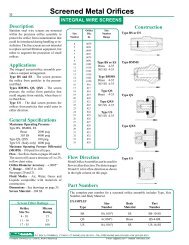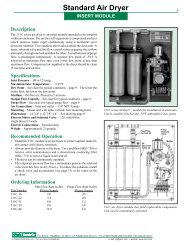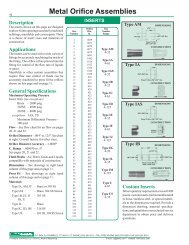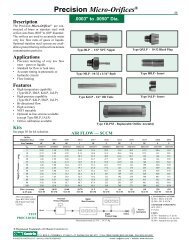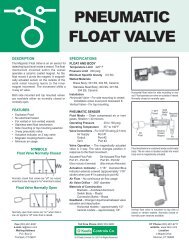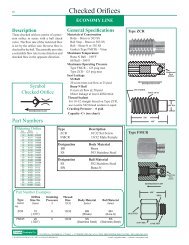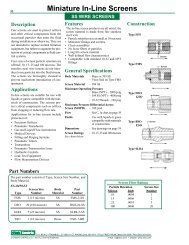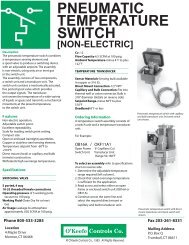Metal Orifice Assemblies - O'Keefe Controls Inc
Metal Orifice Assemblies - O'Keefe Controls Inc
Metal Orifice Assemblies - O'Keefe Controls Inc
You also want an ePaper? Increase the reach of your titles
YUMPU automatically turns print PDFs into web optimized ePapers that Google loves.
Fundamentals of Flow Measurement<br />
The Standard Cubic Foot<br />
Volumetric Flow<br />
The flow of gases is traditionally measured<br />
in volumetric units such as cubic feet, liters<br />
or cubic centimeters. However, since<br />
gases are compressible fluids, the total<br />
mass contained in a given volume varies<br />
with both the temperature and pressure of<br />
the gas. To provide a meaningful reference<br />
for volumetric flow measurements, a<br />
"standard" set of conditions are defined for<br />
temperature and pressure of the gas.<br />
Unfortunately, the definition of standard<br />
conditions varies slightly in technical<br />
disciplines and industry groups. Standard<br />
temperature ranges from 32 to 70ºF (0 to<br />
20ºC). Standard pressure is generally<br />
average atmospheric pressure at sea-level,<br />
14.7 psia.<br />
Standard Conditions<br />
For the data presented in the charts on<br />
pages 20-22, standard conditions are 70°F<br />
and 14.7 psia. For data points measured<br />
by <strong>O'Keefe</strong> <strong>Controls</strong> Co., the same standard<br />
conditions are used.<br />
A mass flowmeter measures flow accurately and<br />
relatively independent of barometric pressure.<br />
The unit shown above is used to obtain the data for<br />
calibrated orifices.<br />
GAS FLOW MEASUREMENT<br />
Factors to Consider<br />
In comparing volumetric flow measurements<br />
taken at different locations and<br />
with different measuring equipment,<br />
the following factors should be considered:<br />
• Definition of Standard Conditions<br />
Between 32ºF and 70ºF, the standard<br />
conditions can vary up to 8%.<br />
• Temperature of the Gas<br />
A 10ºF deviation causes about 1%<br />
error in a rotameter reading. More<br />
or less deviation occurs in other type<br />
flow measuring instruments. The deviations<br />
are predictable and the flow<br />
measurement is correctable.<br />
• Barometric Pressure<br />
Normal atmospheric pressure variations<br />
of ±1/2" Hg. can cause more<br />
than 1% error in rotameters. Altitude<br />
is also an important factor, since the<br />
barometric pressure decreases rapidly<br />
with increasing altitude. At an<br />
elevation of 2,000 ft. above sea level,<br />
rotameter scale readings are in error<br />
by 3-1/2%. These errors can be corrected<br />
quite easily with predictable<br />
correction factors, and accurate<br />
knowledge of barometric pressure.<br />
What To Do To Improve<br />
Measurement Accuracy<br />
In many applications, errors of ±10% in<br />
flow rate are unimportant. In this case,<br />
corrections for 1) standard conditions, 2)<br />
barometric pressure and 3) temperature<br />
are not required.<br />
1. Definition of Standard Conditions<br />
The data on pages 20-22 is for standard<br />
conditions of 70ºF and 14.7 psia. To reconcile<br />
data taken from volumetric instruments<br />
which are referenced to different<br />
standard conditions, use the following<br />
formula:<br />
Q s<br />
= Q m<br />
x P m x T S<br />
Q m<br />
= measured volumetric flow (SCFH)<br />
or (SLPM).<br />
Q s<br />
= volumetric flow corrected to 70ºF<br />
and 14.7 psia.<br />
P m<br />
= standard barometric pressure referenced<br />
by manufacturer (psia). This is generally<br />
14.7 psia.<br />
P S T m<br />
1000 28.86 14.16<br />
1500 28.33 13.91<br />
45<br />
P s<br />
= standard barometric pressure = 14.7 psia.<br />
T m<br />
= Standard absolute temperature referenced<br />
by manufacturer (ºRankine).<br />
T s<br />
= standard absolute temperature = 530ºR.<br />
For Example:<br />
A mass flowmeter manufacturer uses the<br />
following standard conditions:<br />
14.7 psia, 32°F (492°R)<br />
To convert to standard conditions of 70ºF<br />
(530ºR) and 14.7 psia, apply the following:<br />
Q S<br />
= Q m<br />
x P m<br />
x T S<br />
= Q m<br />
x 14.7 x 530<br />
P S<br />
T m<br />
14.7 492<br />
= 1.077 Q m<br />
The volumetric flow Q S<br />
is larger than Q m<br />
by 7.7%. Consult the manufacturer of your<br />
flow measuring equipment to insure that<br />
you know exactly the standard conditions<br />
which apply to your equipment.<br />
2. Temperature Effects<br />
Consult your instrument manufacturer for<br />
temperature correction factors. There are<br />
two temperature considerations.<br />
1. Effect of ambient temperature on the<br />
flow measuring instrument<br />
2. Effect of gas temperature on the flow<br />
measuring instrument<br />
3. Barometric Pressure Effects<br />
Consult your instrument manufacturer for<br />
pressure correction factors. There are two<br />
pressure considerations.<br />
1. Effect of barometric pressure on the<br />
flow measuring instrument<br />
2. Effect of gas pressure on the flow measuring<br />
instrument<br />
Table of Average<br />
Barometric Pressure<br />
Altitude Barometer Atmospheric<br />
Above Sea Level Reading Pressure<br />
Feet <strong>Inc</strong>hes Mercury PSIA<br />
0 29.92 14.696<br />
500 29.38 14.43<br />
2000 27.82 13.66<br />
2500 27.32 13.41<br />
3000 26.82 13.17<br />
3500 26.33 12.93<br />
4000 25.84 12.69<br />
4500 25.37 12.46<br />
5000 24.90 12.23<br />
5500 23.99 11.78<br />
7000 23.10 11.34<br />
8000 22.23 10.91<br />
P.O. BOX Q • TRUMBULL, CT 06611 • CT PHONE (203) 261-6711 • TOLL FREE PHONE (800) 533-3285 • FAX (203) 261-8331<br />
© O'KEEFE CONTROLS CO. • 2003 ALL RIGHTS RESERVED e-mail ca@okcc.com • website www.okcc.com




